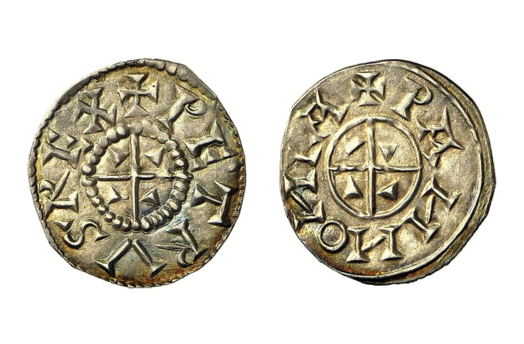
about ancient nomos
Ancient Nomos Art is a museum of galleries exhibiting ancient coins and ancient mint maps. The coin gallery displays the diverse art and history of hand-crafted ancient Greek, Roman, Byzantine, Persian and Medieval coinage. The ancient mints mapping gallery features Greek, Roman, Byzantine, Asia Minor and Medieval mint city regions and territories. Visitor's are welcome to explore, study and enjoy Ancient Nomos Art.

Medieval Hungary – 1038 AD
Peter I Urseolo
From Ancient Galleries

Obverse: +PETRVS REX, central cross in large beaded border with four wedges in each quarter field.
Reverse: +PANNONIA, central cross in a linear circle with four wedges in each quarter field; linear border.
LEGEND
Obv: +PETRVS REX, central cross in large beaded border with four wedges in each quarter field; beaded outer border. Rev: +PANNONIA (N’s retrograde), central cross in a circle with four wedges in each quarter field; linear outer border.
This well preserved medieval Peter I denar specimen (some numismatists label the denomination an obol) was the second coin issued by the emergent Slav state of Hungary during the first reign of Peter. The specimen is also extremely rare due to the very brief reign. As like the Stephan I issues (see Stephan I Denar), these tiny silver Hungarian denars are inscribed with Latin legends and symbolism designed after the western European Carolingian coinage. The early medieval Slavic states actually began issuing coinage after earlier Bavarian silver denar model types, circa 973 AD (P. Barford, The Early Slavs, 2001). As stated, Peter I Urseolo (or Orseolo) was the second king of Hungary who actually reigned twice, first from 1038 – 1041 AD, and second from 1044 – 1046 AD. Sámuel Aba, a descendant of the Khazar Cuman chieftains from the Mátra Hills region, briefly reigned Hungary during the three-year interruption between the reigns of Peter I. Peter was the nephew and nominated heir of Stephen (Istvan) I, the first king of Hungary and founder of the Arpád dynasty and of Ottone Orseolo, the reigning doge of Venice, Italy. After the death of Stephan’s son, Emeric (Imre), in a hunting accident, Stephen appointed Peter as his successor. Unlike Stephen, Peter was a very despotic king who held Magyar nobles in contempt, used force to achieve his goals and exploited the counties wealth and resources. He very quickly alienated many of his nobles, the clergy, and the regional populace at large. Peter I was never able to successfully establish a reciprocating feudal lordship position among the medieval Magyar high Princes, Gyula’s and other nobility clans. At this time, Peter I began issuing his Hungarian coinage in the manner of Stephan I, depicting an obverse Latin legend in his name, abbreviated as PETRVS REX. The reverse coin Latin legend states, PANNONIA, the region (now Hungary) named by the ancient Romans for the land bounded on the north and east by the Danube, west and south by Italy and Dalmatia. This ancient Roman province is still known today as the Pannonian Plains. In 1041 AD, Peter I was removed from the throne, exiled and the nobles proclaimed Sámuel Aba king. While in exile, Peter I found safety in residence with Henry III, the Holy Roman Emperor, who quickly set forth to help Peter returned to power. With the aid of Henry III in 1044 AD, Peter was able to defeat the disaffected Hungarian army under Aba and claim victory at the battle of Ménfo. Peter’s power was then briefly restored, but his second reign of Hungary came at a heavy cost. The Kingdom of Hungary was now a vassal to Henry III, something Stephan I fought very hard to avoid. Peter’s second reign was marked by even greater harm, inflicting harsh revenge upon the nobles and clergy who previously overthrew him. Peter was unable to rule the nation competently and fell into conflict with the largely pagan nobility. The turmoil led to a popular revolt led by the sons of King Vasul of Poland, a relative of Stephen I. Shortly thereafter, Hungarian nobles sent envoys to Kiev requesting the return of Andrew, Levente and Béla, the heirs of Vazul, to overthrow Peter. Peter’s reign ended while he was trying to flee to Austria. He was captured before being able to escape, sent to prison, was blinded, apparently survived the ordeal and died sometime in the 1050’s AD.
DOCUMENTATION
Value: Denier. Metal: AR Silver. Weight: 0.57 grams. Mint: Hungary. Date: Struck circa 1038-41 and 1044-46 AD.
Attribution: L. Huszár. Münzcatalog Ungarn. Munich. 1979, coin 6; Réthy, coin 8; Tibor A. Racz Collection, Pannonia Terra Numismatica and H.D. Rauch, Budapest, Hungary, 2010, lot 12 (this coin).
Legend, Documentation and Attribution
